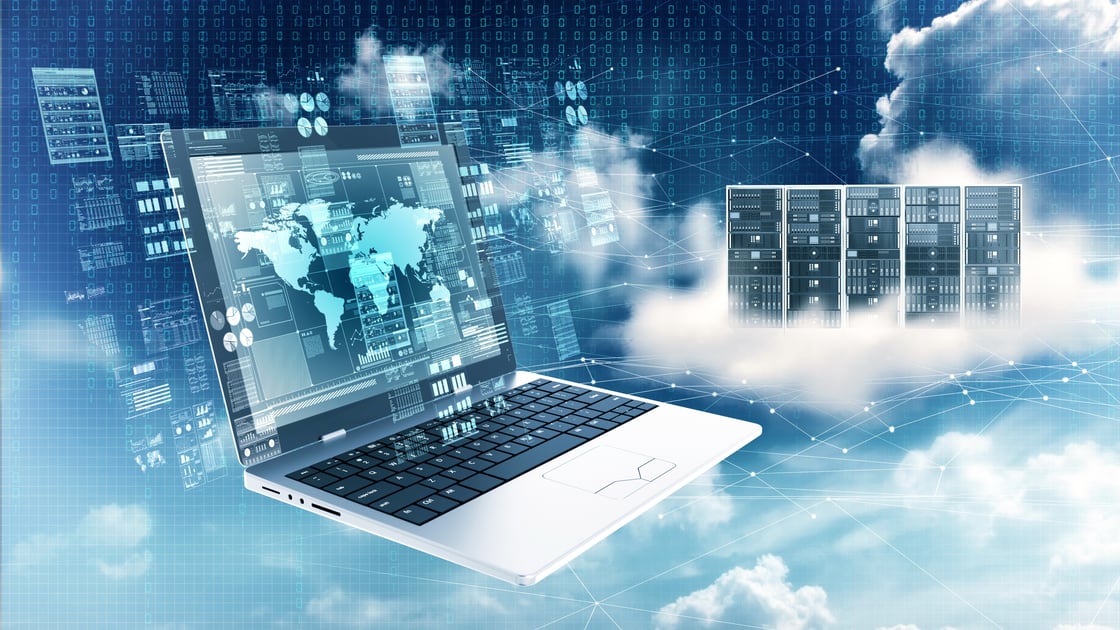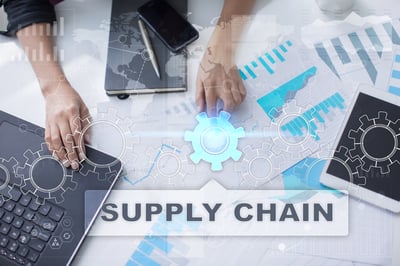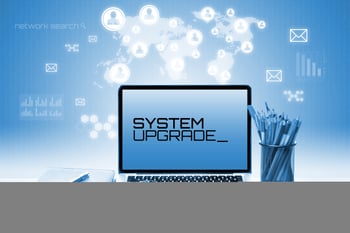
SaaS TMS vs. Cloud TMS: Differences & Which is Better for Your Company
September 7, 2020 •Rick LaGore

 We talk with hundreds of transportation management software (TMS) system buyers every year.
We talk with hundreds of transportation management software (TMS) system buyers every year.
One question we often receive from the TMS buyer is whether the system is a SaaS Cloud TMS or an on premise TMS, with the thinking that Saas and Cloud is the same.
The reality is a SaaS TMS and Cloud TMS are two competing types of software systems that share some similarities, but have many critical differences..
Understanding the terms SaaS TMS and Cloud TMS is the first step in wrapping your head around the enterprise technology landscape.
So with that background in mind, let’s step through a comparison on SaaS TMS and Cloud TMS systems and then take a deeper dive into some of the critical differences that are important to know before making your final decision.
What is Cloud TMS?
 A TMS is a logistics and supply chain software system designed to optimize a company’s freight moves. In an on-premises model, the software runs on an enterprise's on-premises servers and the IT team has complete responsibility for managing the system.
A TMS is a logistics and supply chain software system designed to optimize a company’s freight moves. In an on-premises model, the software runs on an enterprise's on-premises servers and the IT team has complete responsibility for managing the system.
Under a cloud TMS, the software is managed and delivered through remote servers. Companies pay TMS vendors for the functionality and specific resources they need. Users can customize their cloud TMS by adding more resources or removing the ones they're no longer using. This makes a cloud TMS much more flexible and scalable compared to on-premises TMS platforms.
Companies access, input and manage their data in real-time. The TMS vendor handles any maintenance, as well as updates to the hardware and software, as needed.
TMS users can access a cloud TMS through the internet, which enables businesses to more easily share data and collaborate with outside suppliers, partners and customers. Quite often this technology platform results in cost savings for the company.
TMS vendors maintain that a cloud TMS offers increased security, but many business and IT leaders have concerns, such as whether a vendor can access their sensitive information.
Some cloud TMS systems allow companies to have more control over its TMS system, but this choice comes with a higher price, requires more IT resources and is a challenge when the TMS vendor deploys a system upgrade or maintenance patches.
A cloud TMS can be public, private or a hybrid. There are differences in flexibility, security, control, cost, maintenance and scalability with the three different cloud infrastructures.
What is SaaS TMS?
 A SaaS TMS is a type of cloud-based TMS system that is sold through a monthly, per-user subscription and distributed as a service via the internet. A SaaS TMS runs on a vendor's servers, and the vendor updates the software periodically throughout the year.
A SaaS TMS is a type of cloud-based TMS system that is sold through a monthly, per-user subscription and distributed as a service via the internet. A SaaS TMS runs on a vendor's servers, and the vendor updates the software periodically throughout the year.
A SaaS TMS typically runs on a multi-tenant SaaS architecture. TMS vendors keep each tenant's data separate, although they share the software instance and supporting infrastructure and database.
A core benefit of a SaaS TMS system is that it is meant to be easy to use out of the box and the vendor manages updates and maintenance. This helps to promote system security, lower IT costs and protect the ERP system from threats and crashes.
The drawback is that the SaaS TMS typically only offer standard features with little room for customization.
TMS vendors may offer their SaaS TMS in single-tenant mode, in which a tenant does not share its software instance and database with other companies. A single-tenant SaaS TMS offers additional security and privacy, though the cost is higher than in a multi-tenant model.

Is a SaaS or Cloud TMS Better?
The answer to the question of whether a SaaS or Cloud TMS is better comes down to preference, requirements and a company’s future direction.
To help in your decision process we’ll walk through the decision prism on the areas where a SaaS and Cloud TMS differ.
Functionality
 As mentioned earlier the core benefit of a SaaS TMS is that it is meant to be easy to use and implement out of the box. For that reason its functional capabilities are fewer and less customizable that of a cloud TMS.
As mentioned earlier the core benefit of a SaaS TMS is that it is meant to be easy to use and implement out of the box. For that reason its functional capabilities are fewer and less customizable that of a cloud TMS.
For companies that see a TMS as only a freight system and their freight budgets will be less than $10.0 million for many years to come, a SaaS TMS is probably adequate for their company.
However, those shippers with a greater than $10.0 freight budget, no matter their vision on what the TMS could do outside of just managing the freight budget should focus their attention to a cloud TMS.
Market Intent
The market focus and intent of a SaaS and Cloud TMS is different. They are going after two distinct end markets.
A SaaS TMS with its out of the box functionality should be thought of as a freight execution platform. On the other hand, a cloud TMS should be thought of more than just a freight execution system, but a logistics and supply chain platform touching every discipline in an organization to optimize and execute its supply chain connections with vendors, customers and its internal product flow needs.
All said, a cloud TMS has the ability to transform a company into one that delivers a competitive advantage over its rivals through a supplier logistics and supply chain model.
Upgrades
 SaaS and cloud TMS platforms typically have small upgrades or patches put in on a quarterly basis, along with one major upgrade cycle during the year.
SaaS and cloud TMS platforms typically have small upgrades or patches put in on a quarterly basis, along with one major upgrade cycle during the year.
The upgrades tend to be more comprehensive through cloud TMS vendors because they have big investment IT budgets working to build a best in class transportation management platform for the logistics and supply chain market that will put them on the annual Gartner TMS Magic Quadrant Report.
Connectivity & Collaboration
With a cloud TMS system, users should expect to see that they have API integration capabilities with many of the top supplemental systems in the logistics and supply chain industry to further enhance their platform's functionality.
A couple of examples include MercuryGate, which has roughly 60 TMS strategic partners and CH Robinson’s TMC software.
Examples of strategic partners include: ComData, DAT, Fourkites, HubTran, PC Miler, Project 44, SMC3 and Smartway to name just a few.
Implementation Timeline
 The less function rich and SaaS platforms tend to be an out of the box solution that does not take a great deal of resources to implement. These systems have little configuration and customization options available to them making them more of a plug and play option.
The less function rich and SaaS platforms tend to be an out of the box solution that does not take a great deal of resources to implement. These systems have little configuration and customization options available to them making them more of a plug and play option.
This cannot be said for a cloud TMS. As a Certified MercuryGate Integration Partner we find ourselves implementing several MG instances a year and what we tell our clients is the platform is a black box full of customization and configuration options that will need to be designed specifically for their business requirements.
The additional bells and whistles found with a cloud TMS means the timeline for a cloud TMS is extended because it will take longer to deploy than that of a SaaS platform, but with it will come a robust TMS system that is tailored to their organization.
Implementation Cost
The cost of implementing a SaaS TMS will be less than that of a cloud TMS. The out of the box design of a SaaS TMS system makes for a fairly quick and easy solution to begin using.
Because of a longer implementation cycle, the cloud TMS is going to cost more in dollars and internal hours. The internal hours will also be coming from all a company’s disciplines because of the overarching logistics and supply chain functionality a cloud TMS tends to bring to an organization.
While we continue to share that a cloud TMS has a higher intent than that of just a freight IT system, it can act as just a freight platform although it has a lot more horsepower available to organizations. We share this because many companies start small, meaning only deploying the freight aspects of the cloud TMS initially, then gradually bring in the other functional features as time, budget and comfort with the initial install are set.
Fee Structure
 The SaaS and cloud TMS fee structures tend to be a bit different.
The SaaS and cloud TMS fee structures tend to be a bit different.
A cloud TMS is typically a cost per shipment, while a SaaS TMS is by user or site.
There are many SaaS TMS platforms that are offered for free to the shipping market,
Be aware that many of the free TMS systems being offered by logistics companies are SaaS models designed to make money for the logistics company, so do not think they are free.
These free systems are a great option for companies having less than $1.0 million in freight spend and expect that to be the case for the next 3 to 5 years. However, companies with greater freight budgets and a vision of future growth should be very skeptical of the “free TMS” because they may be a trojan horse into your company.
The three areas of skepticism include:
- Freight Cost
- It is true the logistics company will most likely have better rates than the shipper using their platform can get on their own, but a shipper most likely can obtain even lower rates from another logistics company not requiring them to be on their TMS platform.
- The free TMS makes money through profits on the buy-sell spread of the carriers it offers users to access through the freight platform.
- Longevity
- The free TMS vendor’s intent is to keep its users from moving on once they are on the platform. The company is offering free, which is expensive for them initially, but over time becomes quite lucrative through the profits they make on their favorable buy sell side of their carrier base.
- Functionality
- The lowest functionality system is free, but when more capabilities are required you will need to upgrade into the higher tiers, which do come with charges making free now paid.
- The other area to think of before implementing one of the free TMS systems is to understand they often run multiple tiers of their TMS offering.
Additional TMS Resources to Review
.jpeg?width=300&name=ebooks%20-%20Copy%20(3).jpeg) Hopefully you found this article to be helpful.
Hopefully you found this article to be helpful.
Below is a list of other TMS articles you may find to be helpful in your quest for a TMS system:
- A Complete Guide to TMS Freight Software: Market Capabilities and Solutions for Shippers
- Top 12 TMS Implementation Best Practices to Prevent Failure
- Cost of TMS Software: Comparing Cloud vs Licensed Models
- MercuryGate Certified Integrator Channel Partner: Benefits & Value
- Top 15 Benefits of a Cloud-Based TMS System
- Best Transportation Management System (TMS) Software Packages
- Top 10 Transportation Management Software (TMS) Implementation Pitfalls to Avoid
- TMS RFP Template
Learn more about InTek Freight & Logistics , subscribe to our blogs or visit the InTek Online Learning Center.
Get Updates
Featured Articles
Categories
- Freight & Shipping Costs (54)
- Freight Broker (59)
- Freight Forwarder (2)
- Intermodal Transportation (183)
- International & Cross Border Logistics (43)
- Logistics & Supply Chain (418)
- Logistics Service Provider (76)
- LTL (39)
- Managed TMS (49)
- News (39)
- Supply Chain Sustainability (12)
- Transportation Management System (37)
- Truckload (122)
- Warehousing & Distribution (50)



